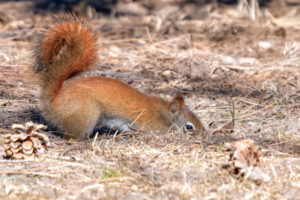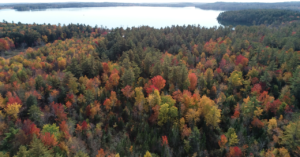In October autumn sets in full swing, the changes this month happen rapidly. Cooler early autumn temps give way to hints of winter chill, and life begins to become more challenging for wildlife. In “Naturally Curious: A Photographic Guide and Month-by-Month Journey through the Fields, Woods, and Marshes of New England” by Mary Holland, October is described as a month of adaptation.
“The summer has come to an end and hints of the coming winter remind us of changes brewing. For many plants and animals, these changes are life threatening. They include the disappearance of the food any relied on over the past six months; the cooling of the aur that determines the body temperature of cold-blooded animals; and strong, cold winds that can quickly desiccate plants. This time of year, provides many examples of ways in which both plants and animals have adapted to New England’s changing seasons.”
Photo: Marie Read, Birds & Blooms
The Blue Jay adapts to the seasonal change by catching food. Blue Jays and several other species of bird are known to store seeds and nuts in the fall, so they have a supply of food for the winter months when food becomes even more scarce. Blue Jays are known to collect half the acorns produced in an oak stand and bury them up to a mile away. Another species we often see storing food in the fall are squirrels. The Red Squirrel will bury their food supply in damp soil, that way the seeds don’t dry out before the squirrel can eat them.
Photo: Brian Reilly, Loon Preservation Committee
This time of year, you may not recognize the Loons that have been living on the lake. As they get closer to migration, they molt their feathers and take on a less striking appearance. Loons may migrate anywhere from 60 miles to 4,000 miles away, some even stay in their home lake year-round. While hiking in the forest you may see some strange signs on the sides of trees. This is a sign of the rut, or mating season for White-Tailed Deer. Male deer antlers harden and the blood supply to the thin layer of skin on the antlers begin to dry up, so the deer must rub the skin off. It may sound gnarly, but this is extremely relieving to the deer. This ritual signals the beginning of mating season which will peak around mid-November.
The most apparent sign that Autumn is in full swing is the changes we see in deciduous trees. As they lose their chlorophyll leaves begin to change colors. Reds, yellows, oranges, and sometimes even purple hues are seen across New England. Bringing tourists from all over to witness the vibrant swan song of summer. Deciduous trees show off these vibrant colors as an adaptation to survive the winter. Available water will be short in the winter and a tree cannot afford to supply its leaves with water during this time. The tree goes dormant by forming an abscission layer at the stem of the leaf. This cuts off water and nutrients to the leaf. This halts photosynthesis and the leaf changes color and falls off. Why don’t conifers lose their leaves? Conifers needles have a waxy layer that protects against water loss. However, during autumn trees like the Easter White Pine do shed some needles, that is why you may notice yellow and brown needles on pine trees. The Eastern White Pines needles have a lifespan of about a year and a half, so older needles further from the tips of the branches have reached their limit. New needles will bud in the springtime at the end of the branches.
Next time you’re out on a walk this month, see what you can notice. Autumn brings stark changes in New England. Spend some time outside while the temperatures are mild and take note of things you notice that are happening that you may not have noticed before? What do you see, smell, hear? Is it quiet? Do you see squirrels frantically scurrying around? Why are some trees yellow and some trees red? The fall is a great time to center your attention on nature.




